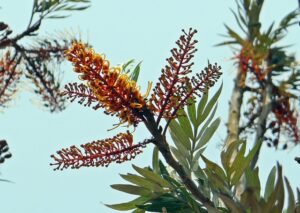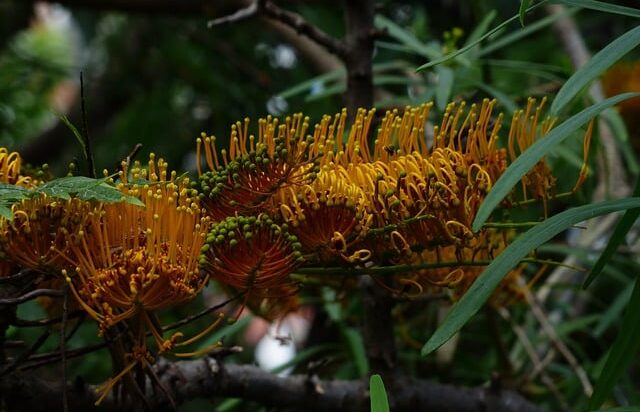Silver oak tree in India has quietly become one of the most admired choices for both farmers and urban gardeners. Whether you’ve spotted its tall, graceful frame lining coffee estates in the south or standing proudly along city roads, there’s something special about this tree.
Its feathery leaves shimmer with a silvery hue in sunlight, making it look both elegant and strong. Many of us remember sitting under its shade on a warm afternoon, without realizing how valuable and versatile this tree really is.
“The silver oak stands tall not just for its beauty but for its purpose—offering shade, wood, and calm to all who rest beneath it.”
Introduction
The Silver Oak (Grevillea robusta) is a fast-growing evergreen tree that has become popular across India for its ornamental value and practical uses.
Originally from Australia, it adapts well to the Indian climate, making it a favorite among farmers, estate owners, and landscapers.

It’s known for its shimmering foliage, deep roots, and straight trunk that grows rapidly even in moderate soils. Apart from being a natural shade tree in coffee and tea plantations, silver oak wood is used in furniture, packing, and even musical instruments.
Here’s a quick look at the basic details of this remarkable tree
| Aspect | Details |
|---|---|
| Scientific Name | Grevillea robusta |
| Family | Proteaceae |
| Common Names | Silver Oak, Silk Oak |
| Native Region | Eastern Australia |
| Height | 20–30 meters |
| Lifespan | 60–80 years |
| Ideal Climate | Tropical and subtropical regions |
| Temperature Range | 10°C to 35°C |
| Soil Type | Well-drained loamy or sandy soil |
| Propagation Method | By seeds or stem cuttings |
History and Origin
The silver oak tree traces its origin to the coastal regions of Queensland and New South Wales in Australia. It belongs to the Proteaceae family, which includes several hardy species known for their resilience and adaptability.
The name “silver oak” comes from its silvery-green leaves that resemble the oak tree, though it is not a true oak.
The tree was introduced to India during the British era, mainly as a shade tree in tea and coffee estates in the southern states. Planters quickly realized how well it grew in local conditions—its tall structure provided just the right shade without competing with main crops.
Over time, silver oak became popular not just for shade but for timber and ornamental purposes. Its wood has a fine grain and light texture, ideal for furniture, window frames, and plywood. The golden-orange flowers that appear in spring also attract bees and birds, adding biodiversity to plantations.
Today, silver oak trees can be seen across India, from Kerala and Karnataka to parts of Maharashtra, Tamil Nadu, and even in the cooler regions of Himachal Pradesh.
Ideal Growing Conditions
The silver oak is known for its adaptability, which makes it an excellent choice for diverse Indian conditions.
Climate:
It thrives in tropical and subtropical climates. The tree grows well in regions with moderate rainfall (about 1000–1500 mm per year). It can tolerate mild frost and drought once mature.
Temperature:
The ideal range for growth is between 10°C and 35°C. Extreme cold below 5°C may damage young saplings, while intense heat above 40°C can slow growth.
Soil:
Silver oak prefers well-drained loamy or sandy soil rich in organic matter. It doesn’t do well in heavy clay soils that retain water. Adding compost or leaf mulch improves its growth.
Sunlight:
The tree loves sunlight. Plant it in a spot with full sun exposure for at least 6–8 hours daily.
Watering:
Regular watering is needed during the first year. Once the roots are established, silver oak becomes drought-tolerant.
Region Suitability:
Best suited for the Western Ghats, central India, and the southern plateau. It’s commonly found in Karnataka, Kerala, Tamil Nadu, Maharashtra, and Telangana.
Popular Varieties of Silver Oak
Though Grevillea robusta is the most popular species grown in India, there are a few related varieties and hybrids used in ornamental landscaping or mixed plantations.
| Variety | Native Place | Flower/Seed Info |
| Grevillea robusta | Australia | Golden-orange flowers |
| Grevillea banksii | Queensland | Red flowers with soft leaves |
| Grevillea pteridifolia | Northern Australia | Yellow-orange brush flowers |
| Grevillea hybrid (Honey Gem) | Horticultural hybrid | Bright orange blooms |
- Native place: Coastal Australia
- Flower name: Golden or orange bottlebrush-like bloom
- Climate type: Tropical to subtropical

Tree Care and Maintenance
The silver oak is not a demanding tree, but it responds well to basic care, especially in its early years.
1. Planting:
Dig a pit of 45 cm x 45 cm and fill it with soil mixed with compost or farmyard manure. Space trees about 5 to 6 meters apart for proper canopy spread.
2. Watering:
Water young plants twice a week for the first six months. Mature trees only need occasional watering during dry spells.
3. Fertilizing:
Apply organic manure or NPK fertilizer once or twice a year to maintain strong growth. Avoid over-fertilizing—it can make branches weak.
4. Pruning:
Prune dead or weak branches during winter. Early pruning helps maintain a straight trunk and healthy structure.
5. Mulching:
Apply a thick layer of leaf mulch or dry grass around the base to retain soil moisture and control weeds.
6. Propagation:
Silver oak is usually propagated through seeds collected from mature pods. Fresh seeds germinate within two to three weeks. For ornamental use, stem cuttings or grafting can be used.
Common Problems and Solutions
| Problem | Cause | Solution |
|---|---|---|
| Root rot | Poor drainage or overwatering | Ensure proper soil drainage and avoid stagnant water |
| Leaf burn | Excess heat or low humidity | Provide partial shade for young plants and regular watering |
| Stem borer | Insect infestation | Apply neem oil or organic insecticide at early signs |
| Powdery mildew | Fungal infection in humid areas | Spray a mild fungicide and improve air circulation |
| Poor growth | Nutrient deficiency | Add compost or balanced fertilizer seasonally |
Most of these problems are manageable through preventive care and proper planting conditions.

Economic and Environmental Importance
The silver oak tree in India plays a vital role both economically and environmentally.
Economic Value
Silver oak wood is light, durable, and resistant to termites, making it suitable for furniture, doors, and packing materials. In plantations, it’s often used as a shade tree for coffee, tea, pepper, and cardamom crops.
The tree grows fast, which means farmers can harvest timber within 20–25 years. A mature tree can yield around 0.3 to 0.5 cubic meters of usable timber.
Its adaptability makes it popular among small farmers as a boundary or intercropping tree. The wood fetches a good market price, especially in southern India, where demand from furniture and plywood industries continues to rise.
Environmental Benefits
Beyond its commercial value, silver oak contributes to soil stabilization and groundwater recharge. Its deep roots prevent soil erosion on slopes, which is why it’s widely used in hilly areas.
The dense canopy also provides shade for plantation crops and supports biodiversity by attracting birds, bees, and pollinators.
As a fast-growing evergreen, it absorbs significant amounts of carbon dioxide, helping offset carbon emissions. It’s now being promoted under several agroforestry programs for sustainable farming.
Scope in India
With rising awareness about eco-friendly farming and timber-based income, silver oak plantations are expanding in Karnataka, Kerala, and Maharashtra.
Farmers are intercropping it with coffee, areca nut, and banana. State horticulture departments and private nurseries supply quality seedlings, making it accessible for both commercial and home growers.
A grevillea wood veneer was used on a Pembroke table, a small table with two drawers and folding sides, made in the 1790s for Commissioner of the Royal Navy, Sir Andrew Snape Hamond. The timber from which the veneer was made, referred to as ‘beef wood’, was sent from Port Jackson by Surgeon-General John White, who arrived in the new penal colony of Australia with the First Fleet. This table is in the collection of the National Museum of Australia in Canberra. (source-wikipedia)
Interesting Facts
|

FAQs
1. How long does the silver oak tree take to grow?
Silver oak grows quickly and can reach 15–20 meters within 10 years under good conditions. It’s considered one of the fastest-growing shade trees in India, suitable for agroforestry and landscaping projects.
2. Is silver oak good for coffee plantations?
Yes. It provides filtered shade without competing much for nutrients or water. Its tall structure and deep roots make it perfect for coffee and pepper farms, improving crop health and yield.
3. Can we plant silver oak near houses?
It’s best to plant it at least 10–15 feet away from buildings. While it offers excellent shade, the tree’s roots spread widely and can disturb foundations if planted too close.
4. Does the silver oak tree require much water?
Not after establishment. Young plants need consistent watering, but mature trees are drought-tolerant. They can survive on natural rainfall in most regions of India.
5. What is the price of silver oak timber in India?
Depending on size and quality, silver oak timber can fetch between ₹1,200 and ₹2,000 per cubic foot. Prices vary by region, age, and local market demand. Farmers growing it commercially often combine it with other shade crops for better long-term profit.
Conclusion
The silver oak tree in India stands as a perfect blend of beauty, utility and sustainability. From its shimmering leaves to its strong timber, every part of this tree serves a purpose.
Whether you’re a farmer looking to diversify your plantation or a gardener searching for a tall, graceful tree for your landscape, silver oak is an ideal choice. It offers shade, income, and environmental value all at once.
Thanks for reading. Keep growing, keep exploring, and don’t forget to return here at gardeningbud.com for more plants, tips and gardening wisdom.
